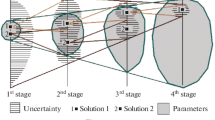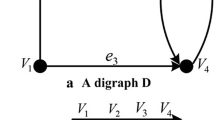Abstract
Usually, there are many solutions to a design problem; therefore, there is scope for producing improved designs if one could explore a large solution space widely. An approach would be to use the computer to synthesise a wide variety of concepts for a given problem, and allow designers to explore these before developing the most promising ones. Adopting a research approach based on developing basic representations, knowledge base and reasoning procedures adequate for synthesising concepts of existing devices and mechanisms, a computer program for synthesising solutions to a class of mechanical design problems has been developed. For a given design problem, the program can produce an exhaustive set of solution concepts, in terms of their topological, spatial and generic physical configurations, which can then be explored by designers. In order to aid designers in the exploration process, an approach for clustering and browsing these concepts has been developed. The program has been tested for its ability to: (1) generate existing as well as innovative ideas of solutions at the various levels; (2) cluster these ideas using measures of similarity used by designers and the difference this makes to the quality of solution space exploration.
Access this chapter
Tax calculation will be finalised at checkout
Purchases are for personal use only
Preview
Unable to display preview. Download preview PDF.
Similar content being viewed by others
References
Pahl G, Beitz W. Engineering design: a systematic approach. 2nd ed. London Berlin: Springer, 1996.
Ullman DG. The evolution of function during design. In: Workshop on Function and Function-to-Form Evolution, Engineering Department, University of Cambridge, 1992; 117–36.
Nidamarthi S, Chakrabarti A, Bligh TP. The significance of co-evolving requirements and solutions in the design process, Proceedings of the International Conference on Engineering Design (ICED97), Tampere, Finland, vol. 1, 1997; 227–30.
Berliner C, Brimson JA, editors. Cost management for today’s advanced manufacturing: the CAM-I conceptual design. Boston: Harvard Business School Press, 1988.
Fricke G. Experimental investigation of individual processes in engineering design. In: Cross N, Doorst K, Roozenburg N, editors. Research in design thinking. Delft University Press: 1992; 105–9.
Ehrlenspiel K, Dylla ND. Experimental investigation of the design process. In: Proceedings of the International Conference on Engineering Design, Harrogate, UK, vol. 1, 1989; 77–95.
Heylighen A, Verstijnen IM. Exploring case-based design in architectural education. In: Proceedings of 6th International Conference on AI in Design (AID00), Worcester, USA, 2000; 413–32.
Blessing LTM, Chakrabarti A, Wallace KM. A design research methodology. In: Proceedings of the International Conference on Engineering Design (ICED95), Praha, 1995; 50–5.
Chakrabarti A. Designing by functions. Ph.D. thesis, University of Cambridge, UK, 1991.
Chakrabarti A, Bligh TP. Functional synthesis of solution-concepts in mechanical conceptual design. Part I: knowledge representation. Int J Res Eng Des 1994;6(3):127–41.
Reinschke KJ. Multivariable control: a graph theoretic approach. Thoma M, Wyner A, editors. Lecture notes in control and information sciences, vol. 108. Delft: Springer, 1988.
Chakrabarti A, Bligh TP. An approach to functional synthesis of solutions in mechanical conceptual design, part II: kind synthesis. Res Eng Des 1996;8(1):52–6.
Chakrabarti A, Bligh TP. An approach to functional synthesis of solutions in mechanical conceptual design, part III: spatial synthesis. Res Eng Des 1996;8(2): 116–24.
Lisp Works reference manual. Harlequin Limited, UK, 1991.
Chakrabarti A, Abel C. The mobile arm support project: evolution of the management, design, tools, and documentation processes. In: Proceedings of the 16th Annual International Conference of the IEEE Engineering in Medicine and Biology Society Conference, Baltimore, MD, USA, vol. 1, 1994; 486–7.
Bauert E The mobile arm support phase I: design, manufacture, testing, software tools. Technical report no. CUED/C-EDC/TR 13, Cambridge University, UK, 1993.
Chakrabarti A, Bligh TP. An approach to functional synthesis of design concepts: theory, application, and emerging research issues. Artif Intell Eng Des Anal Manuf 1996;10:313–31.
Chakrabarti A. Increasing efficiency of compositional synthesis by improving the database of its building blocks. Artif Intell Eng Des Anal Manuf 2000;14:403–14.
Pohl I. Bi-directional search. In: Meltzer B, Mitchie D, editors. Machine Intelligence 6. Edinburgh University Press: 1971; 127–40.
Chakrabarti A. Improving efficiency procedures for compositional synthesis by using bi-directional search. Artif Intell Eng Des Anal Manuf 2001;15:67–80.
Liu Y-C. A methodology for the generation of concepts in mechanical design. Ph.D. thesis, Department of Engineering, University of Cambridge, 2000.
Chakrabarti A, Tang MX. Genenerating conceptual solutions on FuncSION: evolution of a functional synthesiser. In: Gero JS, Sudweeks F, editors. Proceedings of Artificial Intelligence in Design ‘96 (Proceedings of the Fourth International Conference on AI in Design, Stanford, USA). Kluwer Academic, 1996; 603–22.
Liu Y-C, Chakrabarti A, Bligh TP. Using engineering heuristics for efficient exploration of design solution space. Des Stud J 2001;submitted.
Langdon PM, Chakrabarti A. Browsing a large solution space in breadth and depth. In: Proceedings of the International Conference on Engineering Design (ICED99), Munich, vol. 3, 1999; 1865–8.
Chakrabarti A. A framework for browsing a solution space in depth and breadth. Technical report CUED/C-EDC/TR62, Department of Engineering, University of Cambridge, January, 1998.
Langdon PM, Chakrabarti A. Improving access to design solution spaces using visualisation and data reduction techniques. In: ICED01 Conference; Design Research-Theories, Methodologies, and Product Modelling, Glasgow, 2001; 379–86.
Liu Y-C, Chakrabarti A, Bligh TP. A computational framework for concept generation and exploration in mechanical design: further developments of FuncSION. In: Proceedings of the Sixth International Conference on AI in Design (AIDOO), Worcester, July 2000; 499–519.
Liu Y-C, Chakrabarti A, Bligh TP. Developing physical embodiments of concepts in mechanical design. Res Eng Des 2001;submitted.
Chakrabarti A, Johnson AL, Kiriyama T. An approach to automated synthesis of solution principles for micro-sensor designs. In: Proceedings of the International Conference on Engineering Design (ICED97), Tampere, vol. 2, 1997; 125–8.
Bracewell RHB, Johnson AL. From embodiment generation to virtual prototyping. In: Proceedings of the International Conference On Engineering Design (ICED99), Munich, vol. 2, 1999; 685–90.
Editor information
Editors and Affiliations
Rights and permissions
Copyright information
© 2002 Springer-Verlag London
About this chapter
Cite this chapter
Chakrabarti, A., Langdon, P., Liu, YC., Bligh, T.P. (2002). An approach to compositional synthesis of mechanical design concepts using computers. In: Chakrabarti, A. (eds) Engineering Design Synthesis. Springer, London. https://doi.org/10.1007/978-1-4471-3717-7_11
Download citation
DOI: https://doi.org/10.1007/978-1-4471-3717-7_11
Publisher Name: Springer, London
Print ISBN: 978-1-84996-876-8
Online ISBN: 978-1-4471-3717-7
eBook Packages: Springer Book Archive




